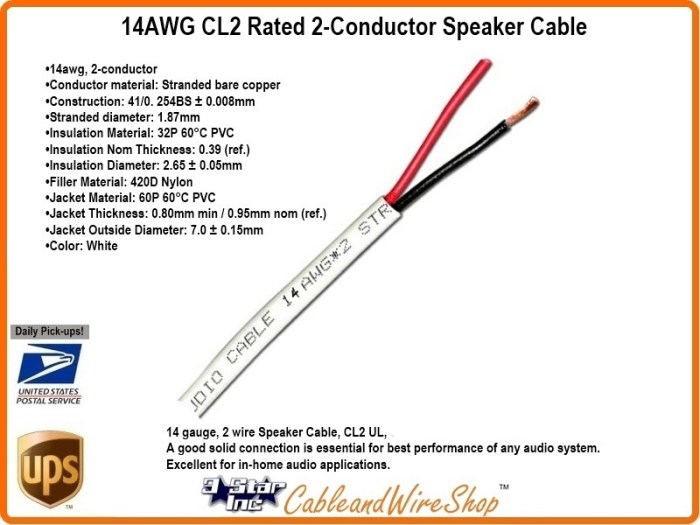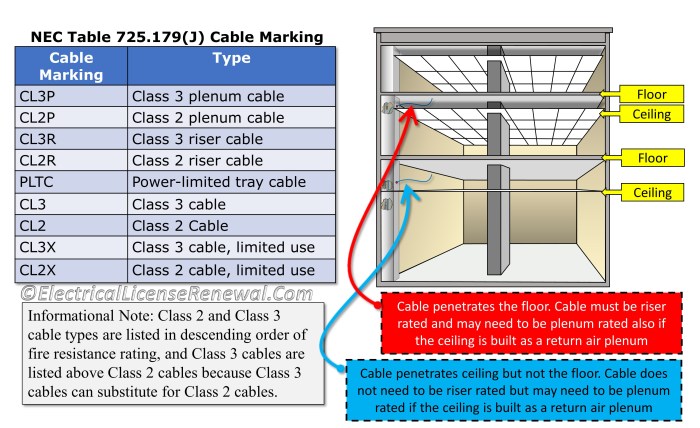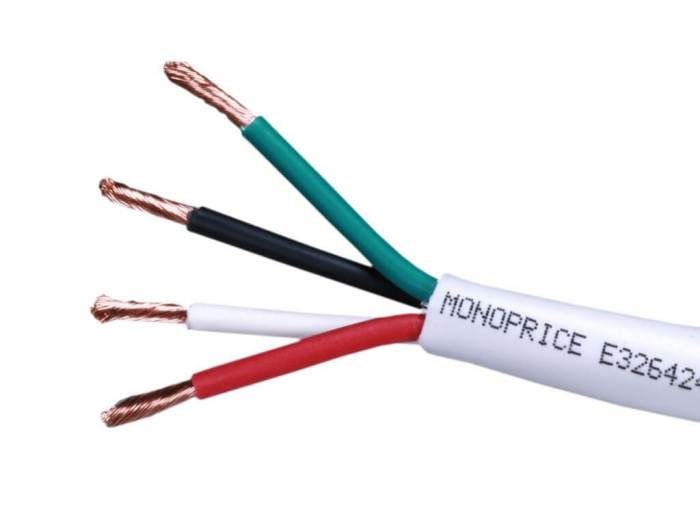A cable marked CL2 is a specialized type of electrical cable designed for specific applications. Its unique characteristics and construction set it apart from other cable types, making it a valuable choice for various electrical installations. This comprehensive guide delves into the world of CL2 cables, exploring their purpose, construction, advantages, and suitable applications.
Understanding the significance of cable markings and adhering to electrical wiring standards is crucial for ensuring safety and compliance. CL2 cables play a vital role in maintaining electrical integrity, and their proper installation and handling are essential for optimal performance.
Electrical Wiring Standards: A Cable Marked Cl2 Is A

Electrical wiring standards are a set of rules and regulations that govern the installation of electrical wiring in buildings. These standards are in place to ensure the safety of people and property by minimizing the risk of electrical fires and other hazards.The
National Electrical Code (NEC) is the most widely used electrical wiring standard in the United States. The NEC is developed by the National Fire Protection Association (NFPA) and is updated every three years. The NEC sets forth minimum requirements for the installation of electrical wiring, including the types of wire that can be used, the size of the wire, and the methods of installation.In
addition to the NEC, there are a number of other electrical wiring standards that are used in different countries and regions. These standards include the International Electrotechnical Commission (IEC) 60364 standard, the British Standard (BS) 7671 standard, and the Canadian Electrical Code (CEC).The
different types of electrical wiring standards have different applications. The NEC is used in the United States, while the IEC 60364 standard is used in many other countries. The BS 7671 standard is used in the United Kingdom, and the CEC is used in Canada.
Cable Markings and Labeling

Cable markings and labeling play a crucial role in electrical systems by providing vital information about the cables’ characteristics, intended use, and safety precautions. They serve as a visual guide for electricians, inspectors, and maintenance personnel, ensuring proper installation, operation, and maintenance.
Cable markings typically include the following information:
- Cable Type:Identifies the type of cable, such as NM (non-metallic sheathed), UF (underground feeder), or MC (metal clad).
- Voltage Rating:Indicates the maximum voltage the cable can safely handle.
- Current Rating:Specifies the maximum current the cable can carry without overheating.
- Conductor Size:Indicates the cross-sectional area of the conductors within the cable.
- Number of Conductors:Indicates the number of individual wires or conductors within the cable.
- Manufacturer’s Name:Identifies the manufacturer of the cable.
- Date of Manufacture:Indicates when the cable was produced.
- Special Markings:May include additional information, such as “CL2” (suitable for use in concealed spaces) or “RHH” (resistant to heat and moisture).
It is essential to follow cable marking guidelines carefully to ensure safety and compliance. Incorrectly labeled cables can lead to misidentification, improper installation, and potential electrical hazards. By adhering to these guidelines, electricians can ensure that cables are installed and used in a manner consistent with their intended purpose and safety requirements.
CL2 Cable Characteristics

CL2 cable, also known as Class 2 cable, is a type of electrical cable designed for specific applications within buildings. It is commonly used in low-voltage applications such as lighting, power distribution, and control systems.
Construction and Materials
CL2 cables typically consist of stranded copper conductors, insulated with a flame-retardant material such as polyvinyl chloride (PVC) or polyethylene (PE). The conductors are then covered with an outer jacket made of a durable material like nylon or PVC.
Advantages, A cable marked cl2 is a
- Flame Resistance:CL2 cables are designed to resist the spread of flames, ensuring safety in case of electrical fires.
- Flexibility:The stranded conductors and flexible outer jacket make CL2 cables easy to install and maneuver in tight spaces.
- Low Smoke Emission:The flame-retardant materials used in CL2 cables minimize smoke emission, reducing potential health hazards during a fire.
Limitations
- Voltage Rating:CL2 cables are typically rated for voltages up to 300 volts, which limits their use in higher-voltage applications.
- Outdoor Use:CL2 cables are not suitable for outdoor use, as they are not weather-resistant and can degrade over time.
- Sunlight Exposure:Prolonged exposure to sunlight can damage the outer jacket of CL2 cables, reducing their lifespan.
Applications of CL2 Cables

CL2 cables are designed for various electrical installations and offer versatility in their usage. Their primary application is in indoor locations, particularly for low-voltage applications.
These cables are commonly employed in residential and commercial buildings for wiring purposes. They are suitable for use in dry or damp areas, making them ideal for both interior and exterior applications.
Common Applications
- Interior wall wiring
- Lighting fixtures
- Power outlets
- Appliance connections
- Security systems
- Intercom systems
CL2 cables are also commonly used in telecommunications and data networking applications. They are suitable for transmitting data signals, telephone lines, and other low-voltage communication systems.
A cable marked CL2 is a type of electrical cable that is approved for use in hazardous locations, such as those containing flammable gases or vapors. For more information on hazardous location wiring, check out unit 3 session 4 letrs . This type of cable is designed to resist damage from moisture, chemicals, and heat, and it is also flame-resistant.
CL2 cables are typically used in commercial and industrial applications, such as factories, warehouses, and hospitals.
Suitability for Different Installations
CL2 cables are well-suited for most indoor electrical installations. They meet the safety requirements for use in dry and damp locations, making them suitable for residential, commercial, and industrial applications.
However, it is important to note that CL2 cables are not rated for direct burial or exposure to harsh environmental conditions. For outdoor applications, it is recommended to use cables with appropriate ratings, such as CLX or UF cables.
Safety Considerations
When using CL2 cables, it is crucial to adhere to the following safety considerations:
- Use only cables that are rated for the intended application and environment.
- Install cables properly according to electrical codes and manufacturer’s instructions.
- Avoid overloading cables or exceeding their current-carrying capacity.
- Protect cables from physical damage and exposure to moisture.
- Have electrical installations inspected and maintained regularly by a qualified electrician.
By following these safety guidelines, you can ensure the safe and reliable operation of CL2 cables in your electrical installations.
Comparison with Other Cable Types

CL2 cables share similarities with other types of electrical cables, such as CL3 and CMR cables, but also exhibit distinct characteristics. Understanding these differences is crucial when selecting the appropriate cable for specific applications.
CL2 vs. CL3 Cables
- Construction:CL2 and CL3 cables have similar constructions, featuring stranded copper conductors, thermoplastic insulation, and a PVC jacket.
- Applications:CL2 cables are primarily used in dry, indoor locations, while CL3 cables are suitable for both dry and damp indoor locations.
- Ratings:CL2 cables are rated for 90°C and 300 volts, whereas CL3 cables are rated for 75°C and 300 volts.
CL2 vs. CMR Cables
- Construction:CMR cables feature a flame-retardant jacket, making them more resistant to fire propagation than CL2 cables.
- Applications:CMR cables are primarily used in commercial and industrial buildings, where fire safety is a priority.
- Ratings:CMR cables have similar ratings to CL2 cables, with a temperature rating of 90°C and a voltage rating of 300 volts.
Factors to Consider When Choosing
When selecting between CL2, CL3, and CMR cables, consider the following factors:
- Location:CL2 cables are suitable for dry indoor locations, while CL3 cables can be used in both dry and damp indoor locations. CMR cables are best suited for commercial and industrial buildings.
- Fire Safety:CMR cables provide enhanced fire resistance compared to CL2 and CL3 cables.
- Temperature and Voltage:All three cable types have similar temperature and voltage ratings, but it’s essential to ensure they meet the specific requirements of the application.
Installation and Handling
CL2 cables are designed to be installed and handled with care to ensure their proper functioning and longevity. Proper installation techniques and precautions are crucial to maintain the integrity of the cables and the electrical system they are part of.
Following manufacturer’s instructions and adhering to industry best practices is essential to ensure the safe and effective installation and handling of CL2 cables.
Cable Preparation
Before installing CL2 cables, it is important to prepare them properly. This includes stripping the insulation to the appropriate length, ensuring clean cuts, and avoiding nicks or cuts to the conductors.
Cable Routing
CL2 cables should be routed through approved pathways, such as conduits, cable trays, or behind walls. They should be secured using appropriate methods to prevent movement or damage.
Cable Connections
When making connections with CL2 cables, it is crucial to use proper connectors and techniques. Ensure secure connections and avoid loose or exposed wires.
Precautions
When working with CL2 cables, certain precautions should be taken to prevent damage or electrical hazards.
- Avoid overbending or kinking the cables.
- Protect the cables from sharp objects or excessive force.
- Do not expose the cables to excessive heat or moisture.
Detailed FAQs
What is the purpose of a CL2 cable?
CL2 cables are primarily used for low-voltage applications, such as powering lighting fixtures, switches, and other electronic devices.
What are the advantages of using CL2 cables?
CL2 cables offer flame resistance, making them suitable for concealed installations within walls and ceilings. They are also flexible and easy to install.
What is the difference between CL2 and CL3 cables?
CL3 cables are rated for use in more demanding applications, such as commercial buildings and industrial settings. They have a higher flame resistance rating and are typically more robust than CL2 cables.